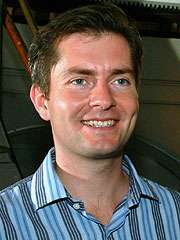David Charbonneau
David Brian Charbonneau is a Professor of Astronomy at Harvard University. His research focuses on the development of novel techniques for the detection and characterization of exoplanets orbiting nearby, Sun-like stars.
David Charbonneau | |
|---|---|
 | |
| Born | |
| Citizenship | Canadian, U.S.A. |
| Alma mater | University of Toronto, Harvard University |
| Known for | Detection and characterization of exoplanets |
| Scientific career | |
| Institutions | Harvard University |
| Thesis | Shadows and Reflections of Extrasolar Planets (2001) |
| Doctoral advisor | Robert W. Noyes, Timothy M. Brown |
Early life and education
David Charbonneau was born in Ottawa, Ontario.[1] He is the son of Brian Charbonneau, a geologist, and Sylvia Charbonneau, a physician.[2][3]
When he was around 12 years old, he visited Pacific Rim National Park with his family, where he spent time playing in tide pools and observing the variety of organisms that lived in the intertidal zone. He credits this experience with sparking an early interest in science.[4] When he was in high school, he read Stephen Hawking's A Brief History of Time. Intrigued by the ideas in the book, he decided to pursue studies in physics and astronomy, rather than biology.[5][4]
Charbonneau received a Bachelor of Science degree in math, physics, and astronomy from the University of Toronto in 1996. At the suggestion of his friend Sara Seager, he applied to the graduate program in astronomy at Harvard University and was accepted.[1] [4] As a graduate student in 1999, he used a 4-inch telescope to make the first detection of an exoplanet eclipsing (or transiting) its parent star, which yielded the first ever constraint on the composition of a planet outside the Solar system. He earned a PhD in astronomy in 2001.[6]
In 2004, the Astronomical Society of the Pacific awarded him the Robert J. Trumpler Award for his graduate thesis entitled Shadows and Reflections of Extrasolar Planets.[7]
Career
Charbonneau was a R. A. Millikan Postdoctoral Scholar in Astronomy at the California Institute of Technology from 2001 until 2004. He returned to Harvard in 2004 where he joined the faculty of the Department of Astronomy.[1][6]
Charbonneau was a founding member of the Trans-Atlantic Exoplanet Survey, which used a worldwide network of humble automated telescopes to survey hundreds of thousands of stars to detect 5 more exoplanets by this technique. Charbonneau also pioneered the use of space-based observatories to undertake the first studies of the atmospheres of these distant worlds: In 2001 he used the Hubble Space Telescope to study directly the chemical make-up of the atmosphere enshrouding one of these exoplanets, and in 2005, he led the team that used the Spitzer Space Telescope to make the first direct detection of the light emitted by an exoplanet. He is currently leading the NSF-funded MEarth Project and is a member of the NASA Kepler Mission Team. Each of these projects aims to detect Earth-like planets that might be suitable abodes for life beyond the Solar system.
Awards and honors
- Robert J. Trumpler Award (2004)
- Alfred P. Sloan Research Fellow (2006–2008)
- David and Lucile Packard Fellowship for Science and Engineering (2006–2011)
- NASA Exceptional Scientific Achievement Medal (2006)
- Discover Magazine Scientist of the Year (2007)
- National Science Foundation's Alan T. Waterman Award (2009)[8]
- Raymond and Beverly Sackler Prize in the Physical Sciences (2012)[9]
- Blavatnik Award (2016)
Selected publications
- Charbonneau, David; Brown, Timothy M.; Latham, David W.; Mayor, Michel (2000-01-20). "Detection of Planetary Transits Across a Sun-like Star". The Astrophysical Journal. 529 (1): L45–L48. arXiv:astro-ph/9911436. Bibcode:2000ApJ...529L..45C. doi:10.1086/312457. ISSN 0004-637X. PMID 10615033.
- Charbonneau, David; Brown, Timothy M.; Noyes, Robert W.; Gilliland, Ronald L. (2002-03-20). "Detection of an Extrasolar Planet Atmosphere". The Astrophysical Journal. 568 (1): 377–384. arXiv:astro-ph/0111544. Bibcode:2002ApJ...568..377C. doi:10.1086/338770. ISSN 0004-637X.
- Charbonneau, David; Allen, Lori E.; Megeath, S. Thomas; Torres, Guillermo; Alonso, Roi; Brown, Timothy M.; Gilliland, Ronald L.; Latham, David W.; Mandushev, Georgi (2005-06-10). "Detection of Thermal Emission from an Extrasolar Planet". The Astrophysical Journal. 626 (1): 523–529. arXiv:astro-ph/0503457. Bibcode:2005ApJ...626..523C. doi:10.1086/429991. ISSN 0004-637X.
- Knutson, Heather A.; Charbonneau, David; Allen, Lori E.; Fortney, Jonathan J.; Agol, Eric; Cowan, Nicolas B.; Showman, Adam P.; Cooper, Curtis S.; Megeath, S. Thomas (2007). "A map of the day–night contrast of the extrasolar planet HD 189733b". Nature. 447 (7141): 183–186. arXiv:0705.0993. Bibcode:2007Natur.447..183K. doi:10.1038/nature05782. ISSN 0028-0836. PMID 17495920.
- Fressin, Francois; Torres, Guillermo; Rowe, Jason F.; Charbonneau, David; Rogers, Leslie A.; Ballard, Sarah; Batalha, Natalie M.; Borucki, William J.; Bryson, Stephen T. (2012). "Two Earth-sized planets orbiting Kepler-20" (PDF). Nature. 482 (7384): 195–198. arXiv:1112.4550. Bibcode:2012Natur.482..195F. doi:10.1038/nature10780. ISSN 0028-0836. PMID 22186831.
- Dressing, Courtney D.; Charbonneau, David (2013-03-28). "The Occurrence Rate of Small Planets around Small Stars". The Astrophysical Journal. 767 (1): 95. arXiv:1302.1647. Bibcode:2013ApJ...767...95D. doi:10.1088/0004-637X/767/1/95. ISSN 0004-637X.
Personal life
Charbonneau is married to Margaret Bourdeaux, a global health advocate and physician. They have four daughters.[10]
References
- http://www.nasonline.org, National Academy of Sciences -. "David Charbonneau". www.nasonline.org. Retrieved 2018-11-29.
- "Stork report - Selena Jordan Charbonneau". Wicked Local. Retrieved 2018-11-29.
- "Scientist of the Year: David Charbonneau | DiscoverMagazine.com". Discover Magazine. Retrieved 2018-11-29.
- Ellerbroek, Lucas (2017-09-15). Planet Hunters: The Search for Extraterrestrial Life. Reaktion Books. ISBN 9781780238784.
- Phil, Mozel (2010). "A Moment With...Dr. David Charbonneau". Journal of the Royal Astronomical Society of Canada. 104 (5): 210. Bibcode:2010JRASC.104..210M. ISSN 0035-872X.
- "David Charbonneau at Harvard University". www.cfa.harvard.edu. Retrieved 2018-11-29.
- "ASP: 2004 Award Winners Press Release". www.astrosociety.org. Retrieved 2018-11-30.
- "Archived copy". Archived from the original on 2009-03-09. Retrieved 2009-03-05.CS1 maint: archived copy as title (link)
- "The Raymond & Beverly Sackler Prize in the Physical Sciences - Laureates 2012".
- "Interview With Margaret Bourdeaux – TEDxBeaconStreet". TEDxBeaconStreet. Retrieved 2018-11-29.